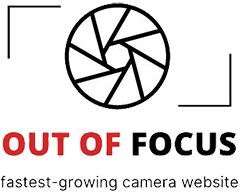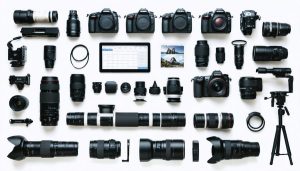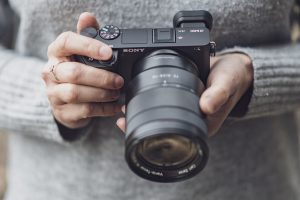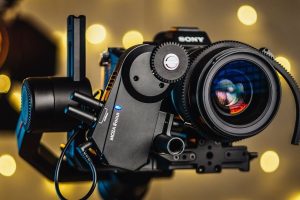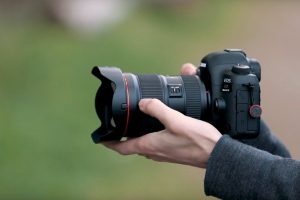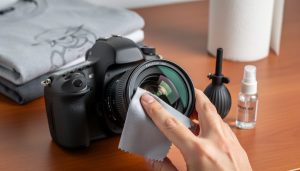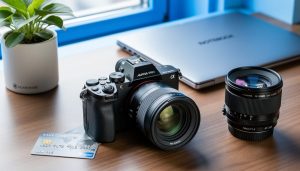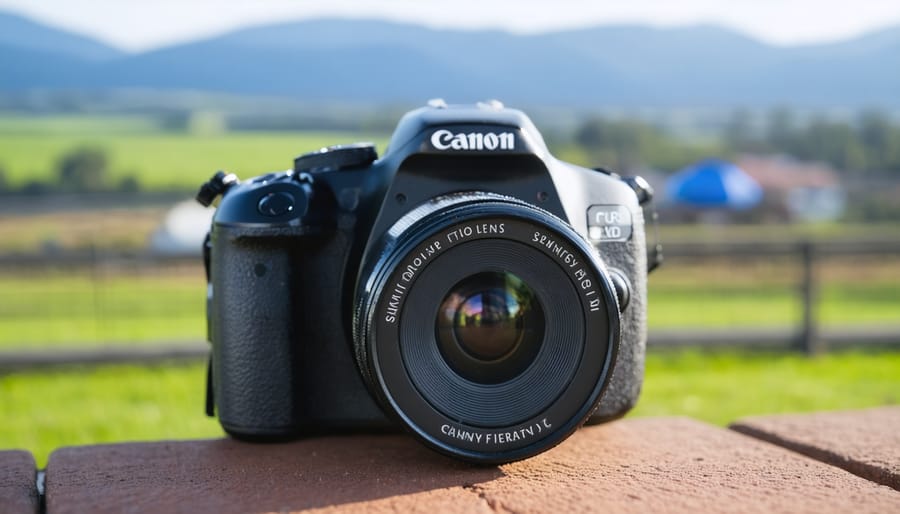
Invest in quality lenses before upgrading your camera body – they typically deliver more significant image quality improvements than a new camera alone. While modern camera sensors continue to evolve, a premium lens remains the cornerstone of exceptional photography, often outlasting several camera generations. Professional photographers consistently prioritize their best lenses for Canon cameras and other systems over frequent body upgrades, understanding that superior glass captures sharper details, better contrast, and more accurate colors regardless of the camera body’s age.
Think of your camera system like a human eye – the sensor functions like the retina, but the lens acts as the cornea, controlling how light reaches the sensor. Even the most advanced sensor can’t compensate for poor-quality glass, while a exceptional lens can help an entry-level camera produce stunning results. From enhanced bokeh and faster autofocus to better low-light performance and increased durability, quality lenses fundamentally transform your photography capabilities in ways that sensor improvements alone cannot match.
The Truth About Image Quality: It’s All in the Glass
Resolution and Sharpness
When it comes to image quality, lens sharpness plays a crucial role in determining how much detail your camera can capture. Even the highest-resolution sensor won’t deliver crisp images if paired with a low-quality lens. Think of it like watching a 4K movie through a dirty window – the content might be high-resolution, but what you see will be compromised.
High-quality lenses feature superior optical designs and better glass elements that minimize distortion and maximize clarity. They’re engineered to resolve more detail, which becomes particularly noticeable when you zoom in on your images or make large prints. Professional-grade lenses often deliver edge-to-edge sharpness, while budget options might be sharp only in the center.
Consider this: a 20-year-old premium lens on a modern camera can often produce sharper images than a cheap kit lens on the latest high-megapixel body. This is why many photographers prioritize lens investments over frequent camera body upgrades. The resolution potential of your lens acts as a ceiling for your final image quality, regardless of your camera’s capabilities.
Remember that different lenses perform best at different apertures, typically delivering peak sharpness between f/5.6 and f/8. Understanding these sweet spots helps maximize your lens’s resolution potential.

Color and Contrast
A lens’s optical coatings and glass quality play crucial roles in how your images look, particularly regarding color rendition and contrast. High-quality lenses feature advanced multi-coating technologies that reduce lens flare and ghosting while enhancing light transmission. The way lens coating affects image quality is particularly noticeable in challenging lighting conditions, such as shooting towards the sun or working with bright light sources.
Premium lens elements, especially those using specialized glass like fluorite or extra-low dispersion (ED) elements, minimize chromatic aberration and deliver more accurate colors. This results in images with better color fidelity and cleaner transitions between light and dark areas. You’ll notice this improvement most dramatically in high-contrast scenes, where cheaper lenses might struggle with color fringing along edges.
The contrast difference between basic and premium lenses becomes apparent in real-world shooting. A high-quality lens will produce images with more depth and dimensionality, making subjects appear to pop from the background with clearer separation and more nuanced tonal gradations. This enhanced micro-contrast is particularly valuable for portrait and landscape photographers who rely on subtle tonal differences to create impact in their images.
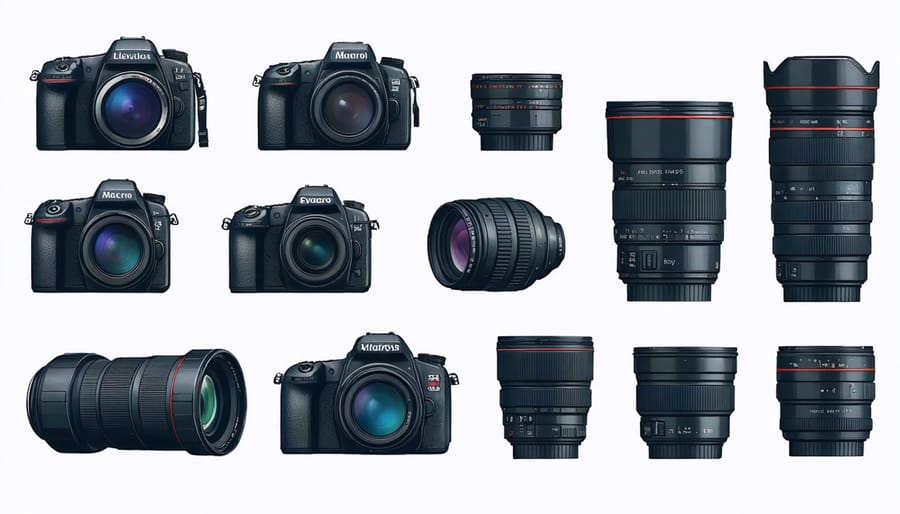
How Different Lenses Transform Your Photography
Prime vs. Zoom Lenses
When it comes to improving your photography, understanding prime and zoom lens differences is crucial. Prime lenses, which have a fixed focal length, typically offer superior image quality and wider maximum apertures (like f/1.4 or f/1.8) compared to zoom lenses at a similar price point. This allows for better low-light performance and that coveted background blur, or bokeh, that many photographers seek.
Zoom lenses, on the other hand, offer versatility that can’t be matched by prime lenses. Being able to adjust your focal length without changing lenses means you’re more likely to catch fleeting moments, especially in dynamic situations like weddings or sports events. While they might not match the absolute sharpness or low-light capabilities of prime lenses, modern zoom lenses have come a long way in terms of image quality.
Consider this practical example: A 24-70mm f/2.8 zoom lens might serve you well for general photography, offering good image quality across its range. However, a 50mm f/1.4 prime lens will give you superior bokeh and better performance in dim conditions, albeit at a fixed focal length. The choice often comes down to your shooting style and needs.
For beginners looking to improve their kit, starting with a prime lens can be an excellent learning tool. The fixed focal length forces you to move and think more carefully about composition, while the wider aperture opens up creative possibilities. More experienced photographers often carry both types, using primes for specific scenarios where image quality is paramount and zooms for situations requiring flexibility.
Specialty Lenses and Their Magic
Specialty lenses open up entirely new creative possibilities that standard lenses simply can’t match. Take macro lenses, for instance – these remarkable pieces of glass allow you to capture the intricate details of a butterfly’s wing or the delicate patterns of a flower’s petals with stunning clarity. They achieve 1:1 magnification or greater, revealing a hidden world that’s invisible to the naked eye.
Tilt-shift lenses are another fascinating category that can dramatically transform your photography. By allowing you to manipulate the plane of focus, these lenses can create that distinctive “miniature effect” often seen in cityscape photography, or achieve perfect focus across an entire architectural facade. While they’re primarily used in professional architecture and product photography, creative photographers are increasingly using them for unique artistic effects.
Fisheye lenses offer an ultra-wide perspective with characteristic curved distortion, perfect for creating dramatic environmental shots or capturing tight interior spaces. Meanwhile, super-telephoto lenses bring distant subjects incredibly close, making them invaluable for wildlife and sports photography.
Each specialty lens serves as a specific tool for specific creative challenges. For example, a 100mm macro lens might be mediocre for landscape photography, but it’s unbeatable for capturing the details in jewelry photography. Similarly, while a tilt-shift lens might be overkill for casual portraits, it’s essential for professional architectural work.
The magic of specialty lenses lies not just in their technical capabilities, but in how they enable photographers to realize their creative vision in ways that would otherwise be impossible. They don’t necessarily make your camera “better,” but they do expand its creative possibilities exponentially.
Investment Strategy: Body vs. Glass
When it comes to photography gear investment, many photographers face a common dilemma: should they upgrade their camera body or invest in better lenses? The answer often lies in understanding the long-term value proposition of each component. While camera bodies tend to depreciate quickly due to rapid technological advancement, quality lenses can maintain their value and utility for decades.
Think of it this way: camera bodies are like computers, with new models featuring improved processors, better sensors, and enhanced features released every few years. Lenses, on the other hand, are more like fine musical instruments – their optical quality and craftsmanship remain valuable long after purchase. Following smart lens investment strategies can help you build a collection that retains its worth over time.
Consider this practical example: A high-end camera body purchased five years ago for $3,000 might now be worth $800-1,000, while a professional-grade lens bought for the same price could still command $2,000-2,500 in the used market. This retention of value isn’t just about resale – it’s about sustained performance and utility.
Professional photographers often keep their lenses through multiple camera body upgrades. A sharp, well-built lens from 15 years ago can still produce stunning images on today’s latest cameras, while a camera body from the same era might feel desperately outdated. This is because fundamental optical principles haven’t changed, while digital technology continues to evolve rapidly.
Moreover, investing in quality lenses often yields more immediate improvements in image quality than upgrading your camera body. A premium lens on an entry-level camera will typically produce better results than a kit lens on a professional body. The lens’s ability to render detail, control aberrations, and perform in low light has a direct impact on every image you capture.
Real-World Examples: Before and After
Let’s look at some real-world comparisons that demonstrate the impact of lens quality on image output. I recently conducted a test using a Canon EOS R6 paired with two different 50mm lenses: a budget-friendly f/1.8 lens and a professional-grade f/1.2L lens.
In the first scenario, shooting a portrait in natural light, the difference was immediately apparent. While both lenses captured the subject clearly, the professional lens produced noticeably smoother bokeh, better contrast, and superior sharpness even when shooting wide open. The skin tones appeared more natural, and the transition from sharp to out-of-focus areas was more pleasing to the eye.
For landscape photography, I tested both a kit 18-55mm lens and a premium 16-35mm f/2.8L lens. The superior lens showed better corner-to-corner sharpness, minimal chromatic aberration, and improved color rendition. When viewing the images at 100%, the difference in detail retention was striking, particularly in challenging situations like sunrise shots where the kit lens struggled with lens flare and contrast.
Architecture photography provided another telling example. Using a basic zoom versus a high-end tilt-shift lens, the difference in perspective control and edge distortion was dramatic. The premium lens maintained straight lines and proper proportions, while the basic zoom showed noticeable barrel distortion and softer edges.
These real-world tests confirm that while a good camera body is important, lens quality often makes a more significant impact on final image quality, especially in challenging shooting conditions or when pushing creative boundaries.

In conclusion, lenses do make a significant difference in your camera’s performance and creative capabilities. While a high-quality camera body is important, investing in good glass often yields more noticeable improvements in image quality, versatility, and creative possibilities. The right lens can enhance sharpness, improve low-light performance, and provide unique perspectives that simply aren’t possible with a kit lens.
When planning your lens investment, start by identifying your primary photography needs. Consider beginning with a versatile prime lens in the 35mm or 50mm range, which offers excellent image quality and low-light performance at a reasonable price point. As your skills and requirements grow, gradually build your collection with lenses that serve specific purposes, such as macro photography or portraiture.
Remember that while expensive lenses often offer superior performance, mid-range options can provide excellent value for money. Focus on quality over quantity, and don’t feel pressured to buy everything at once. A carefully chosen lens collection built over time will serve you better than rushing to acquire multiple average-quality lenses. Most importantly, invest in lenses that align with your photographic vision and shooting style.
